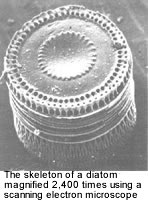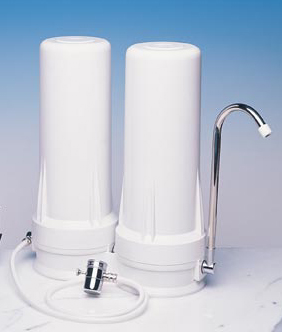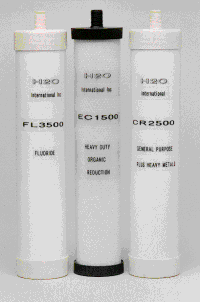Q1) When does a ceramic filter element need cleaning?
A1) Once the flow out of the filter becomes noticeably less than normal.


Q2) How do I clean a filter candle?
A2) Use a scouring pad (similar to 3M “Scotchbrite”). Ensure that the end of the plastic mount does not come into contact with unfiltered water and dirty hands. Rubber gloves are recommended to be used during cleaning and NEVER use soap or detergents!


Q3) My filter candle blocks up too regularly, what can I do about it?
A3) In some water conditions, there is so much particulate or turbidity in the water supply that the filter element becomes blocked much quicker than in normal conditions. In these circumstances, it is beneficial to use a pre-filter upstream of the ceramic candle. This prevents the candle from becoming blocked too quickly, minimizes cleaning and so extends the life of the ceramic filter.

Q4) When does a ceramic filter element need replacing? A4) This depends on the type of candle being used:
Two stage ceramics should be replaced once cleaning fails to restore the water flow. However, we usually recommend that these candles are replaced after 10,000 litres of water have passed through the candle, to guarantee optimum performance.
Three and four stage ceramics.
In combination filter elements (ceramic shells containing other types of filter media) cleaning the ceramic will not extend the life of the internal material. For example, the ‘life' of the carbon block in the filter elements is determined by the concentration of chlorine and/or volatile organic compounds in the water supply. The particulate and turbidity concentration in the water supply govern the life of the ceramic. This means that the life of the ceramic might or might not exceed the capacity of the carbon insert, depending on the water quality. Whichever point is reached first – the twelve months maximum usage or the ceramic becoming blocked to the extent where cleaning does not restore the flow – governs when the filter element requires replacing.
In most cases, the filter element should be replaced after 6 - 12 months of daily use. The following flow guidelines can be used to guarantee optimum performance:
Two stage 700 US gallons
Three stage 1400 US gallons
Four stage 1200 US gallons
After this amount of water has passed through the filter element, the filter will need to be replaced to guarantee optimum performance.

Q5) I don't have a flow meter to gauge the amount of water that my filter has treated. How can I estimate how much water has passed through the filter?
A5) On average a family of four uses approximately 8 litres of water per day for cooking and drinking. Therefore, based on 10 litres/day for four people the life of your filter can be estimated in time rather than capacity. However, once a cartridge has become wet it should be replaced at least every twelve months regardless of use.


Q6) Do I need to sterilize the candle after cleaning?
A6) The ceramic shell of all our filter elements contain trace amounts of silver to prevent microbiological growth. These elements are self-sterilizing and should NOT be sterilized after cleaning. In the case of combination filter elements, boiling will damage the internal components of the element.


Q7) How do I keep my filter housing clean?
A7) The filter housing is best cleaned by unscrewing the body from the head and wiping the surface and the inside of the body with a soft cloth dampened with warm water.
IMPORTANT – DO NOT ATTEMPT TO CLEAN THE FILTER HEAD, WHICH COULD CAUSE CONTAMINATION OF THE FILTERED WATER.

Q8) What happens if I leave the filter unused for a period of time? A8) If normal use of the filter is interrupted by holidays or vacations, growth of harmless heterotrophic bacteria may result in a ‘flat' or ‘stale' taste for a period of time when use of the filter resumes. This is especially true for the filter elements that contain activated carbon such as the Nepgen cartridge (contains granular activated carbon), the three and four stage cartridges (both contain an extruded activated carbon core). Flushing the filter system for several minutes after any prolonged period of inactivity should eliminate the problem.

Q9) What is the difference between temporary and permanent hardness in water? A9) Hardness caused by the presence of positively charged metal ions. Total hardness is measured as the equivalent of milligrams per litre of calcium carbonate. Temporary hardness only contains metal carbonates and bicarbonates, the most typical being calcium carbonate. Temporary hardness is precipitated from water when heated and is responsible for the furring of heating elements and metal pipes. Permanent hardness consists of non-carbonate based metal salts, and does not precipitate out on heating.

Q10) Will my BelKraft filter element remove hardness? A10) Unfortunately filtration does not remove hardness from water so our filter elements will not affect the hardness in drinking water. Hardness can be removed by our BelKraft ‘No Salt' water softener.

Q11) Will hardness affect the performance of our ceramic filter element? A11) The ATS media used in our four stage ceramic filters will adsorb lead, even in the presence of calcium and magnesium ions. This is proven in the NSF certification testing. One of the test protocols for metal(s) reduction calls for testing at high pH, high TDS conditions to simulate use in hard waters. Filter elements containing ATS have to pass this part of the test protocol before they can receive NSF certification.

Q12) Will my BelKraft filter element remove Aluminum? A12) The BelKraft's rage of ceramic water filters are only suitable for the removal of aluminum in particulate form. They are not proven to be suitable for treating dissolved aluminum. To treat water containing soluble aluminum, ion exchange resin with our Dual system or reverse osmosis must be used.

Q13) Will my BelKraft filter element remove Arsenic? A13) No, Arsenic is likely to be in a dissolved state, to remove arsenic passage through activated alumina is the best method. The Belkraft triple system is designed for Arsenic removal.


Q14) Will my BelKraft filter element remove all types of bacteria?
A14) No. The large number of different species of bacteria of different shape, size and growth characteristics, preclude the ceramic filter from being effective against all of them.
The pathogenic bacteria that FICL claim to be effective against have been qualified by test data from independent test laboratories or are extrapolated from test data of similar microorganisms (please seek advice from FICL on permitted extrapolated claims).
Although the ceramic will filter all types of heterotrophic bacteria to some extent, it should be noted that any harmless bacteria of this type passing through the ceramic may multiply downstream of the filter. Since these heterotrophic bacteria are harmless, normally there are no problems and some heterotrophic bacteria are reported to be beneficial to health. However, if normal use of the filter is interrupted by holidays or vacations, growth of these bacteria may result in a ‘flat' or ‘stale' taste for a period of time when use of the filter resumes. This is especially true for the filter elements that contain activated carbon such as the Nepjen cartridge (contains granular activated carbon), the 3 and 4 stage cartridges (both contain an extruded activated carbon core). Any system containing activated carbon, which will reduce residual levels of free chlorine, will result in an increase in plate counts over a short period of time until a constant state of equilibrium is established. The UK Drinking Water Inspectorate water regulations call for the water to be regularly monitored for consistency as used, therefore since an equilibrium point is reached in the filtered water, the filters comply with the regulations. The presence of this type of heterotrophic bacteria does not constitute a health problem since the organisms present will be harmless and a suitable level of consistency would be established. Flushing the filter system for several minutes after any prolonged period of inactivity should eliminate the problem.


Q15) Will my BelKraft filter element remove Chloramine?
A15) Chloramine may be removed by passing through a bed of activated carbon, but requires much greater contact time with the carbon than chlorine, so a slow flow rate through the carbon must be ensured. To reduce the levels of Chloramine you will need to restrict the flow rate from the filter.

Q16) Will my BelKraft filter remove diesel, petroleum or MTBE?
A16) The ceramic part of our filter elements will not take out any of these organic materials. The activated carbon in the 3 and 4 stage filter elements will have greater effect..


Q17) Will my BelKraft filter element remove Fluoride?
A17) No. Fluoride salts are soluble in water. To remove dissolved fluoride, passage through activated alumina is the best method. The Belkraft triple system is designed for Fluoride removal.


Q18) Will my BelKraft filter element remove Iron?
A18) Our ceramic water filters are only suitable for the removal of iron in particulate form. They are not proven as suitable for treating dissolved iron. To treat water containing soluble iron, the iron must be oxidised to induce precipitation prior to filtration. Alternatively the BelKraft iron filter or reverse osmosis can be used.

Q19) Will my BelKraft filter element remove Legionella? A19) Since Legionella has a similar morphology to E-coli, our ceramic filter elements should provide similar protection against Legionella . However, Legionella is capable of slow regrowth downstream of the filter, so if just one organism passes through the ceramic it could eventually colonise the water delivery system. Therefore it is important to regularly disinfect downstream of the filter or fit a UV light just after the filter.

Q20) Will my BelKraft element remove Manganese? A20) No, to remove Manganese, oxidation treatment and filtration can be done, or for low levels of contamination, Green sand or Inversand can be used.

Q21) Will my BelKraft filter element remove Nitrates? A21) Unfortunately the ceramic filter elements will not remove nitrates. In the home the only effective method that can be used to remove nitrates is ion exchange media with the BelKraft Dual system.


Q22) Will my BelKraft filter element remove Oestrogen and Synthetic Oestrogen?
A22) There has been a limited amount of research into Oestrogen and Synthetic Oestrogen, and so we do not have quantifiable test data on the effectiveness of our products in removing it. Due to the chemical properties of Oestrogen, we believe that activated carbon would be effective in reducing it. However until better test methodology is available, we are unable make a claim.

Q23) Will my BelKraft filter element remove Pseudamonas aeroginosa? A23) Pseudomonas aeroginosa is a potential coloniser of water system networks and is similar in size to E-coli. FICL candles should therefore, in theory, show a similar reduction efficiency for Pseudomonas aeroginosa as for E-coli. However, since this organism is rapid growing and may recover quickly, without physically testing FICL ceramic filters with this type of organism, it is impossible to predict a performance claim. FICL is not prepared to attempt a prediction of performance, since the filters provide a <99.99% barrier, but do not provide 100% barrier to E-coli. A limited number of cells may pass through the filter which, unlike E-coli, may form colonies down stream of the filter. It would be more suitable to combine filtration with a disinfection stage to ensure removal of Pseudomonas aeroginosa.

Q24) Why does the pH of my drinking water increase when I use my ceramic filter? A24) The slight increase in the pH of water passed through the ceramic filters is due to the presence of the mineral Wollastonite in the ceramic. Wollastonite is slightly soluble and alkaline, so may partly dissolve in the water as it passes through the filter causing a minor pH shift which is harmless. No health based guideline value for pH in drinking water has been proposed by the WHO, although accompanying notes to the guidelines state that the pH range is often in the range of 6.5-9.5. In general there is little evidence to suggest that pH in potable water of around 9-10 is of public health significance.


Q25) What level of bacterial contamination can the ceramic cope with before I need to use something else?
A25) In the absence of conclusive data regarding the levels of infective doses for specific pathogens, the FICL microbiological laboratory has been testing our filter elements for many years using an influent challenge of 6 log of E-Coli to substantiate the 4 log E-coli reduction claim that we make. This level of protection offered by the filters is more than adequate in all protected waters and the vast majority of moderately contaminated surface waters. However, if the level of contamination in the water exceeds levels of 10 4 (4log) an additional treatment must be used such as disinfection or UV light treatment. It would be extremely unusual for water having a greater level of contamination than 10 4 , to be considered suitable as a potable water source.
 |